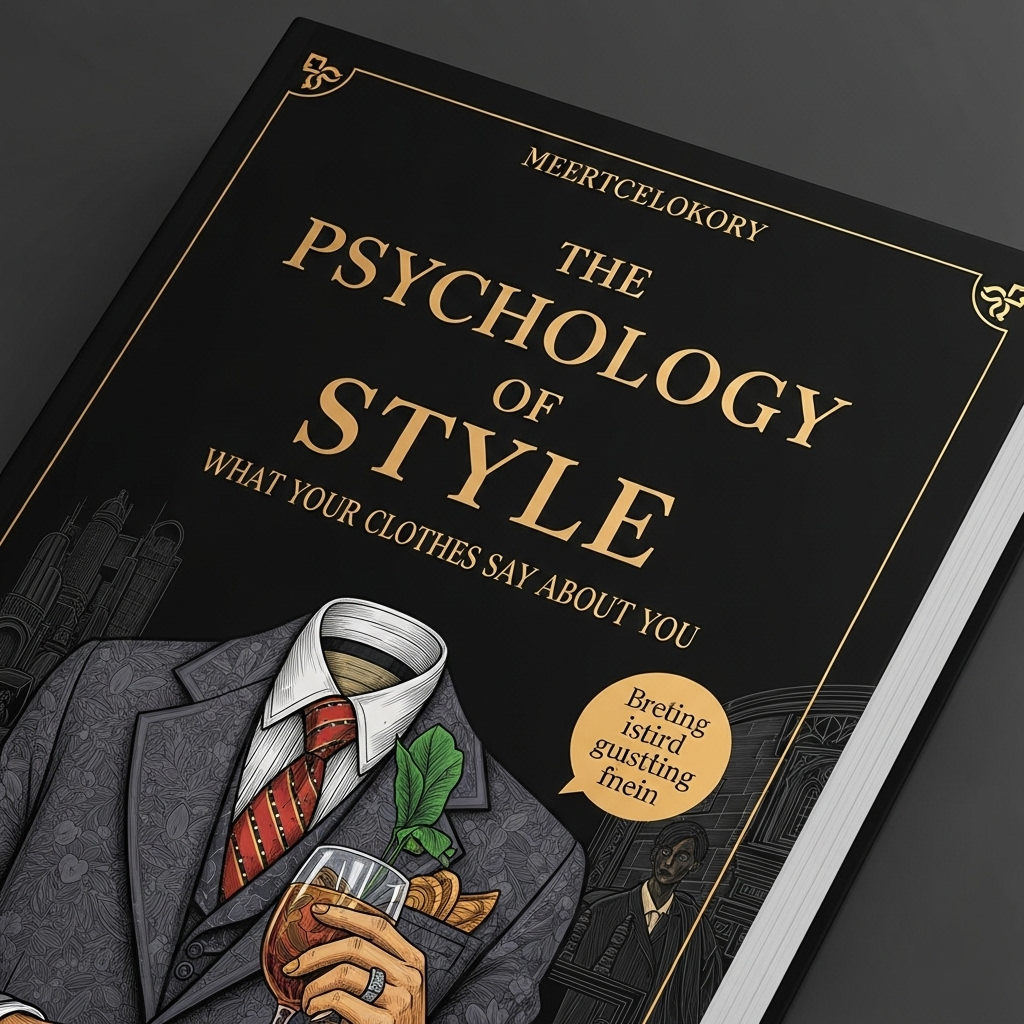Blog
The Psychology of Style: What Your Clothes Say About You

We often hear the adage, “Dress for the job you want, not the job you have.” This simple piece of advice encapsulates a profound truth: our clothing choices are far more than mere utilitarian acts. They are a powerful, often subconscious, language we use to communicate with the world around us. The psychology of style delves into the intricate relationship between what we wear and how we think, feel, and are perceived. It reveals that every stitch, every color, and every silhouette we choose is loaded with meaning, acting as a non-verbal billboard of our identity, aspirations, and current emotional state.
First Impressions: The Silent Communicator
Before we even utter a word, our clothing has already spoken volumes. This is the bedrock of the first impression. Within mere seconds, someone forms an opinion about us based on our attire – are we trustworthy, competent, approachable, or authoritative? A sharp suit might convey professionalism and seriousness, while a vibrant, eclectic outfit could suggest creativity and an adventurous spirit. These initial judgments, while sometimes superficial, can profoundly influence social interactions, job interviews, or even casual encounters. Studies have consistently shown that people dressed in formal attire are perceived as more intelligent and successful, while those in casual wear might be seen as more friendly and approachable. We instinctively decode these visual cues, shaping our responses long before a verbal exchange begins.
Self-Expression and Identity: Wearing Your Soul on Your Sleeve
Beyond external perceptions, clothing serves as a profound tool for self-expression and identity formation. Our style is a canvas upon which we paint who we are, or who we aspire to be. It allows us to communicate our personality, our values, our cultural affiliations, and even our rebellion against societal norms.
Consider the stark differences between a minimalist’s wardrobe, characterized by clean lines and neutral tones, and a maximalist’s explosion of colors and patterns. Each reflects a distinct internal landscape. A punk rocker’s ripped jeans and band t-shirt are not just clothes; they are a manifesto against the mainstream. Similarly, the meticulous curation of vintage pieces can signal an appreciation for history and individuality, while the embrace of cutting-edge trends might reflect a desire to be forward-thinking and modern. Our clothing choices can align us with specific subcultures, signal our political beliefs, or simply affirm our unique aesthetic preferences. It’s a continuous dialogue between our inner selves and our outward presentation.
Mood and Emotion: The Power of Dopamine Dressing
Have you ever noticed how putting on a particular outfit can instantly shift your mood? This isn’t just anecdotal; it’s a phenomenon known as “dopamine dressing.” The concept suggests that wearing clothes that bring us joy can actually trigger the release of dopamine, a neurotransmitter associated with pleasure and reward. Bright colors, luxurious fabrics, or simply a favorite garment can act as mood boosters.
Conversely, our mood can also dictate our fashion choices. On days we feel low, we might gravitate towards comfortable, subdued clothes, retreating into a sartorial shell. When we feel confident and energized, we might choose bolder, more adventurous pieces that mirror our internal state. Understanding this bidirectional relationship allows us to harness clothing as a therapeutic tool – consciously choosing outfits that uplift us, empower us, and help us project the energy we desire, even if we don’t initially feel it. It’s about dressing for the mood you want to be in.
Confidence and Empowerment: The ‘Power Suit’ Effect
The link between clothing and confidence is undeniable. When we feel good about what we’re wearing, we stand taller, speak more clearly, and project an aura of self-assurance. This is the essence of the “enclothed cognition” theory, which posits that the clothes we wear can literally change our psychological processes. For instance, studies have shown that subjects performing cognitive tasks while wearing a doctor’s lab coat (associated with attentiveness) performed better than those wearing a painter’s smock.
The classic example is the “power suit.” Donning a well-tailored suit can evoke feelings of professionalism, authority, and competence. It’s not just about how others see us; it’s about how we internalize the attributes associated with that attire. When we dress for success, we often feel more capable of achieving it. This extends beyond formal wear; for an artist, a paint-splattered smock might be their “power uniform,” signaling their creative prowess and dedication to their craft. The right outfit can be a psychological armor, empowering us to face challenges with greater conviction.
Social Signalling: Decoding the Unspoken Rules
Clothing has always been a powerful tool for social signalling, conveying messages about status, wealth, affiliation, and cultural identity without a single word being spoken. Historically, sumptuary laws dictated who could wear what, but even in modern society, unspoken rules persist.
Designer labels, for instance, are classic examples of status symbols. Wearing a recognizable luxury brand often signifies wealth and a certain social standing. Uniforms, whether for a school, a profession, or a sports team, instantly communicate affiliation and a sense of belonging. Cultural attire, from a traditional sari to a Scottish kilt, signals heritage and identity, fostering a sense of community and pride. Even within informal settings, clothing can signify allegiance to a particular music genre, political movement, or lifestyle choice. We constantly read these signals, consciously or unconsciously, to navigate our social landscape and understand where others stand.
Conformity vs. Individuality: The Eternal Tension
Fashion often exists in a fascinating tension between the desire to conform and the urge for individuality. Humans are social creatures, and the desire to fit in is strong. Following trends, even subtle ones, can provide a sense of belonging and social acceptance. When a particular style becomes popular, adopting it can feel like a natural way to connect with peers.
However, there’s an equally powerful human desire to stand out, to express one’s unique personality. This is where individual style truly shines. Rebellious fashion movements throughout history – from punk to grunge – were direct reactions against prevailing norms, asserting individuality through deliberately unconventional dress. Even within mainstream fashion, personal style allows us to adapt trends to our unique tastes, ensuring we don’t become mere carbon copies. The balance between fitting in and expressing one’s distinct self is a continuous dance, played out every time we open our wardrobe.
The Role of Trends and the Desire for Belonging
Why do we follow trends? Beyond the allure of novelty, trends tap into our fundamental human need for belonging. When a particular style gains widespread acceptance, it creates a shared visual language. Wearing trendy items can make us feel connected to a larger group, giving us a sense of being “in the know” or part of the contemporary zeitgeist. Fashion brands cleverly leverage this, creating a sense of urgency and exclusivity around new collections to drive desire. However, the pursuit of trends also raises questions about authenticity and whether we’re truly expressing ourselves or simply following the crowd. A healthy approach involves discerning which trends genuinely resonate with our personal style rather than blindly adopting every passing fad.
Ethical Considerations and Personal Values: Conscience in Clothing
In recent years, the psychological landscape of fashion has expanded to include ethical considerations and personal values. As awareness of the fashion industry’s environmental and social impact grows, consumers are increasingly making choices based on their conscience. Opting for sustainable brands, purchasing second-hand items, or supporting fair-trade producers is no longer just an economic decision; it’s a reflection of deeper personal values.
Choosing to buy from brands that align with our ethics can foster a sense of integrity and purpose. Conversely, supporting brands with questionable practices can create cognitive dissonance. This shift signifies a maturation in the psychology of style, where external appearance is increasingly linked to internal moral compasses. Our clothing choices are becoming a statement not just about who we are visually, but about what we stand for in the world.
Conclusion: A Deeper Understanding of Our Wardrobe
The psychology of style is a rich and complex field that underscores the profound connection between our inner world and our outer presentation. Our clothes are not just fabric; they are a powerful medium for communication, a tool for self-expression, a mood enhancer, and a reflection of our values. By becoming more aware of the psychological underpinnings of our fashion choices, we can unlock a deeper understanding of ourselves, harness the transformative power of dress, and communicate more intentionally with the world, one outfit at a time. So, the next time you get dressed, consider not just what you want to wear, but what you want to say.
